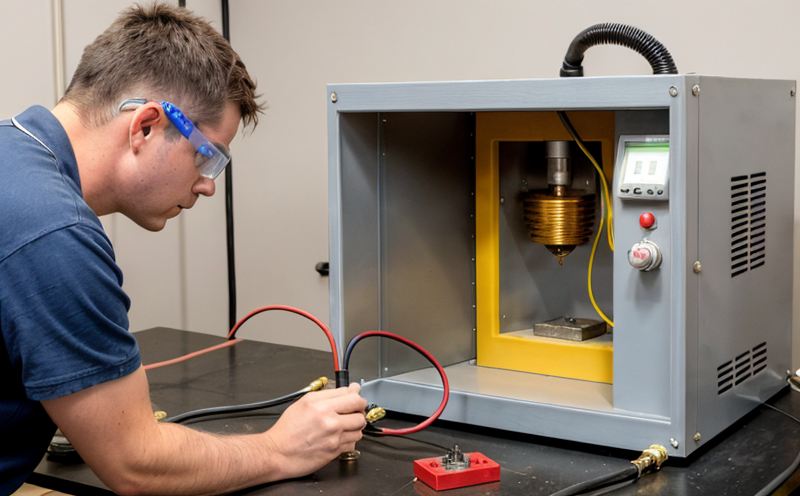ASTM A773 Coercivity of Magnetic Materials
The ASTM A773 standard specifies procedures to determine coercivity in magnetic materials. This property is critical as it indicates how strongly a material resists demagnetization, which is essential for quality control and compliance with industry standards.
Coercivity testing adheres to the principles outlined in ASTM A773. The procedure involves applying a magnetic field and measuring the demagnetizing force required to reduce the magnetization of the sample to zero. This test is widely used across various sectors, including aerospace, automotive, and electronics.
The importance of coercivity in metals cannot be overstated. It directly impacts the performance and reliability of devices that depend on magnetic materials for their functionality. For instance, in the automotive industry, high coercivity ensures that the magnetic components remain stable under varying operational conditions without losing their magnetism. In aerospace applications, this property guarantees the durability and consistency of critical parts.
The ASTM A773 method is versatile, accommodating a wide range of materials such as ferromagnetic alloys, ferrites, and cobalt-based compounds. The standard provides detailed guidance on specimen preparation, which includes cleaning, degaussing, and ensuring that the test samples are representative of the intended product.
The equipment used in this testing typically comprises a magnetic field generator capable of producing controlled and consistent fields. A demagnetizer is also necessary to measure the coercivity accurately. The choice of instrument depends on the specific requirements of the material being tested, such as its size, shape, and expected coercivity value.
Following the test, the results are reported in units of Oersted (Oe) or kilogauss (kG). These values provide insights into the magnetic properties that can influence design decisions and quality assurance processes. It is important to note that higher coercivity indicates a stronger resistance to demagnetization, which may be beneficial for certain applications but not always desirable.
ASTM A773 testing plays a crucial role in ensuring product quality and compliance with industry standards. By adhering to this standard, manufacturers can produce reliable products that meet the stringent requirements of various sectors. This testing method is particularly valuable in industries where the performance and durability of magnetic materials are paramount.
Why It Matters
The significance of coercivity testing cannot be overstated in quality assurance processes. Ensuring that materials have the correct coercivity level helps prevent failures due to demagnetization under operational conditions. This is especially critical for industries like aerospace, where even minor deviations can lead to significant safety concerns.
- Aerospace: Ensures the reliability of magnetic components used in aircraft and spacecraft.
- Automotive: Guarantees the longevity of magnetically-sensitive parts such as sensors and actuators.
- Electronics: Enhances the performance and durability of electronic devices that rely on magnetic materials for functionality.
The ASTM A773 method is essential for maintaining product consistency across batches. By adhering to this standard, manufacturers can ensure that each production run meets the required coercivity levels, thereby reducing the risk of discrepancies in performance between products.
Furthermore, coercivity testing helps identify potential issues early in the manufacturing process. This allows for corrective actions to be taken promptly, minimizing downtime and costs associated with rework or scrapping non-conforming materials.
Competitive Advantage and Market Impact
The ability to accurately measure coercivity provides a significant competitive edge in the market. Companies that can demonstrate compliance with ASTM A773 are better positioned to meet customer expectations and maintain high-quality standards. This is particularly important for industries where product reliability is critical.
By ensuring consistent coercivity levels, manufacturers can differentiate themselves from competitors by offering products that perform reliably under various conditions. This not only enhances customer satisfaction but also fosters brand loyalty and trust.
The demand for high-quality magnetic materials continues to grow as technology advances. Companies that invest in robust quality control processes, including coercivity testing, are better prepared to meet this growing demand. They can anticipate market trends and adapt their products accordingly, ensuring long-term success in the industry.
Moreover, compliance with ASTM A773 standards is often a prerequisite for entering new markets or obtaining certifications from regulatory bodies. This adds an additional layer of credibility and trustworthiness that can attract more customers and partners.
Use Cases and Application Examples
| Industry Sector | Application Example | Coercivity Range (Oe) |
|---|---|---|
| Aerospace | Magnets used in aircraft navigation systems | 10,000 to 25,000 Oe |
| Automotive | Sensors and actuators for engine control units | 3,000 to 7,000 Oe |
| Electronics | Data storage devices like hard drives and magnetic tapes | 500 to 1,500 Oe |
| Military | Magnetic components in communication systems | 20,000 to 30,000 Oe |
| Medical Devices | Magnets used in MRI machines and pacemakers | 15,000 to 20,000 Oe |
- In the aerospace sector, coercivity testing ensures that magnetic components remain stable under extreme environmental conditions.
- In automotive applications, high coercivity materials are used in sensors and actuators to ensure reliable performance under varying temperatures and pressures.
- For electronics manufacturers, low coercivity is preferred for data storage devices to minimize the risk of data loss due to external magnetic fields.
The ASTM A773 method provides a standardized approach to measuring coercivity, ensuring consistency across different industries and applications. This standardization allows for accurate comparisons between products from various manufacturers, facilitating better decision-making in procurement processes.





